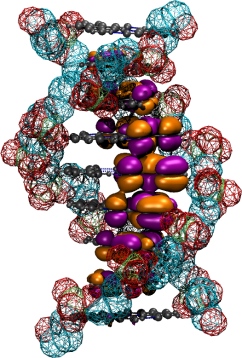We present a hybrid method based on a combination of quantum/classical molecular dynamics (MD) simulations and a mod el Hamiltonian approach to describe charge transport through bio-molecular wires with variable lengths in presence o f a solvent. The core of our approach consists in a mapping of the bio-molecular electronic structure, as obtained f rom density-functional based tight-binding calculations of molecular structures along MD trajectories, onto a low di mensional model Hamiltonian including the coupling to a dissipative bosonic environment. The latter encodes fluctuat ion effects arising from the solvent and from the molecular conformational dynamics. We apply this approach to the c ase of pG-pC and pA-pT DNA oligomers as paradigmatic cases and show that the DNA conformational fluctuations are essential in determining and supporting charge transport.

We present a hybrid method based on a combination of quantum/classical molecular dynamics (MD) simulations and a mod el Hamiltonian approach to describe charge transport through bio-molecular wires with variable lengths in presence o f a solvent. The core of our approach consists in a mapping of the bio-molecular electronic structure, as obtained f rom density-functional based tight-binding calculations of molecular structures along MD trajectories, onto a low di mensional model Hamiltonian including the coupling to a dissipative bosonic environment. The latter encodes fluctuat ion effects arising from the solvent and from the molecular conformational dynamics. We apply this approach to the c ase of pG-pC and pA-pT DNA oligomers as paradigmatic cases and show that the DNA conformational fluctuations are essential in determining and supporting charge transport.
